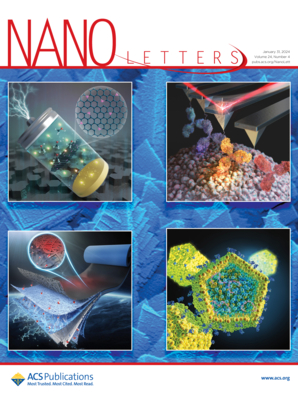Membrane-less Aluminum Displacement Batteries Based on Transition Metal Chlorination in Molten Salts
IF 9.6
1区 材料科学
Q1 CHEMISTRY, MULTIDISCIPLINARY
引用次数: 0
Abstract
Stationary electrochemical energy storage calls for low-cost and high-safety next-generation chemistries, among which the Na-NiCl2 battery based on the displacement reaction stands out but is threatened by the fragile β″-Al2O3 membrane. Here we present a class of low-lost, medium-temperature (150 °C), membrane-less aluminum displacement batteries (ADBs) based on a reversible solid-to-solid displacement reaction between transition metals (TM; Fe, Co, Ni) and their chlorides (TMCs) in alkali chloroaluminate molten salts. Crucially, manipulation of the Lewis acidity of the chloroaluminate molten salt electrolyte enables membrane-less operation of the cell by restricting solubility of the TMC and its crosstalk with the Al negative electrode. The structured Ni cathode exhibits a high capacity of 380 mA h g–1, low overpotential of ∼50 mV at the rate of 0.2 A g–1, and high stability over 500 cycles. Furthermore, we demonstrate a membrane-less Al–Fe displacement battery that promises an ultralow-cost avenue for stationary energy storage.

基于熔融盐过渡金属氯化的无膜铝置换电池
固定式电化学储能需要低成本、高安全的下一代化学物质,其中基于位移反应的Na-NiCl2电池脱颖而出,但受到脆弱的β″-Al2O3膜的威胁。在这里,我们提出了一类低损耗、中温(150°C)、无膜铝置换电池(ADBs),该电池基于过渡金属(TM;Fe, Co, Ni)及其氯化物(TMCs)在碱氯铝酸盐熔盐中的应用。至关重要的是,通过控制氯铝酸盐熔盐电解质的刘易斯酸度,通过限制TMC的溶解度及其与Al负极的串扰,可以实现电池的无膜操作。该结构的Ni阴极具有380 mA h g-1的高容量,在0.2 a g-1的速率下过电位低至~ 50 mV,并且在500次循环中具有很高的稳定性。此外,我们展示了一种无膜Al-Fe置换电池,有望为固定能量存储提供超低成本的途径。
本文章由计算机程序翻译,如有差异,请以英文原文为准。
求助全文
约1分钟内获得全文
求助全文
来源期刊

Nano Letters
工程技术-材料科学:综合
CiteScore
16.80
自引率
2.80%
发文量
1182
审稿时长
1.4 months
期刊介绍:
Nano Letters serves as a dynamic platform for promptly disseminating original results in fundamental, applied, and emerging research across all facets of nanoscience and nanotechnology. A pivotal criterion for inclusion within Nano Letters is the convergence of at least two different areas or disciplines, ensuring a rich interdisciplinary scope. The journal is dedicated to fostering exploration in diverse areas, including:
- Experimental and theoretical findings on physical, chemical, and biological phenomena at the nanoscale
- Synthesis, characterization, and processing of organic, inorganic, polymer, and hybrid nanomaterials through physical, chemical, and biological methodologies
- Modeling and simulation of synthetic, assembly, and interaction processes
- Realization of integrated nanostructures and nano-engineered devices exhibiting advanced performance
- Applications of nanoscale materials in living and environmental systems
Nano Letters is committed to advancing and showcasing groundbreaking research that intersects various domains, fostering innovation and collaboration in the ever-evolving field of nanoscience and nanotechnology.
 求助内容:
求助内容: 应助结果提醒方式:
应助结果提醒方式:


